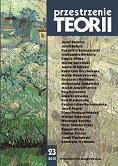Sposoby ukazywania obozów nazistowskich w sztuce zwanej naiwną
Nazi camps as depicted in naive art
Author(s): Katarzyna GrzybowskaSubject(s): History, Fine Arts / Performing Arts, Visual Arts, Recent History (1900 till today), Fascism, Nazism and WW II, History of the Holocaust
Published by: Uniwersytet Adama Mickiewicza
Keywords: concentration camp; folk sculpture; representation crisis; Holocaust;
Summary/Abstract: The paper presents the realizations of the theme of concentration camps in folk art, i.e. the sculptures made by Władysław Chajec, Zygmunt Skrętowicz, Franciszek Skocz, and Jan Staszak. Chajec and Staszak tried to present the most drastic moments in the history of the Nazi death factories. These sculptors drew inspiration from the popular iconography of the Holocaust, i.e. pictures showing the liberation of the camps. Skocz carved a cycle of figures that represent members of the SS and prisoners who are doing labor and who are being subjected to punishment, whereas Staszak decided to create his works by using wood from the trees growing on the borders of the Auschwitz-Birkenau camp, thus treating these plants as witnesses of suffering. This article presents the aforementioned works against the background of the crisis of representation, which permeates culture after the Holocaust.
Journal: Przestrzenie Teorii
- Issue Year: 2015
- Issue No: 23
- Page Range: 121-135
- Page Count: 15
- Language: Polish

